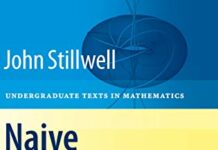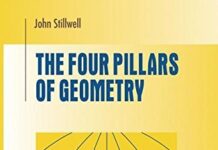
Ebook Info
- Published: 2010
- Number of pages: 196 pages
- Format: PDF
- File Size: 7.47 MB
- Authors: John Stillwell
Description
Algebra is abstract mathematics – let us make no bones about it – yet it is also applied mathematics in its best and purest form. It is not abstraction for its own sake, but abstraction for the sake of efficiency, power and insight. Algebra emerged from the struggle to solve concrete, physical problems in geometry, and succeeded after 2000 years of failure by other forms of mathematics. It did this by exposing the mathematical structure of geometry, and by providing the tools to analyse it. This is typical of the way algebra is applied; it is the best and purest form of application because it reveals the simplest and most universal mathematical structures. The present book aims to foster a proper appreciation of algebra by showing abstraction at work on concrete problems, the classical problems of construction by straightedge and compass. These problems originated in the time of Euclid, when geometry and number theory were paramount, and were not solved until th the 19 century, with the advent of abstract algebra. As we now know, alge bra brings about a unification of geometry, number theory and indeed most branches of mathematics. This is not really surprising when one has a historical understanding of the subject, which I also hope to impart.
User’s Reviews
Reviews from Amazon users which were colected at the time this book was published on the website:
⭐This is a lean book with serious content. It is also the first book on higher algebra that I attempted to read. Now I understand why mathematicians of the past took pains in their attempts to solve cubic, biquadratic and quintic equations. It all began with the construction problems in geometry and arithmetic solution of geometric theorems. Algebra brings all those things together, provides new grounds and even leads us to better things. Algebra is something most of us hate in school because, back then, it seemed so pointless solving some odd equations. With Stillwell’s book, everything now makes perfect sense. Historical backgrounds and underlying concepts of the subject woven together into a very satisfying account. This book is a very pleasurable read and its educational value is superb. Stillwell provides us with a grand insight that only someone who spend his entire career in mathematics can do. Algebra has become a delightful thing with Stillwell’s treatment. It should be a compulsory read for every undergrads who had to study abstract algebra in college.Elements of Algebra is best studied along with
⭐, also by Stillwell, which expands some of the topics that is treated too briefly in this book.
⭐I used this book for self study, and found it refreshingly fun. It combines algebra and geometry in a good way – great for people with spatial abilities. Well, at least the first half of the book was good. The second half was hard to follow, and I have not yet finished the book.
⭐Absolutely ecstatic with the quality of the product! Looks new! Thank you so much
⭐AAA
⭐Today there is a dangerously firm consensus on what should constitute the abstract algebra courses. Authors have been given the freedom to forget all about motivation. They often begin chapters by claiming that “it is necessary to…” and then they give the usual hyperabstract definitions and theorems.* Stillwell’s book on the other hand is the perfect book for those of us who are not satisfied by merely being told what is necessary or what is interesting. Stillwell always explains why. The understanding of context and motivation often comes from an understanding of the historical development. Stillwell discusses these matters in an informal manner that is pleasant to read and very enlightening. The goal of the book is to show the unifying and clarifying role of algebra in mathematics, reaching a natural high point with Galois theory. With these goals, instead of abstraction for its own sake, it turns out that quite a bit of the modern abstract algebra machinery is not really necessary after all. Just as an illustration: this book contains no commutative diagrams at all.*) There appears to be a trend away from this attitude, but never as well executed as in Stillwell. The third edition of Stewart’s Galois Theory is an example of how previously minimalist texts are being padded with lots of chitchat while little has changed in substance. The very mainstream algebra book of Beachy & Blair introduces the chapter on groups by saying that “the human body exhibits bilateral symmetry”. There is none of this vague, pretentious nonsense in Stillwell.
⭐This book does an excellent job of developing core algebraic theories at a level appropriate for undergraduates in a way that links them to other disciplines of mathematics so as to reveal some of the power of algebraic tools when they are used to reveal fundamental properties of mathematical structures and relationships among them, especially geometry, topology and number theory. I have to admit that I’ve become a “fan” of Stillwell’s expository style and perspective on the development of mathematical topics and theories for undergraduates. i’ve found his The Four Pillars of Geometry –
⭐- to be excellent, too.
⭐Another excellent exposition by John Stilwell of more-than-high-school mathematics, with no further requirement. A must for all those who like toread enjoyable texts on such foundational topics, but reject the all-pervasive “Proposition/Proof/That’s it, Figure-it-out-yourself/Proposition…” style on math books. For the rest of us. If “Elements of Number Theory” is recommended before diving into Dedekind’s “Theory of Algebraic Integers”, this one is great to prepare yourself for Emil Artin.Thanks again, John.
⭐The title of this book is misleading. It essentially a book on Galois Theory based upon a course Dr. Stillwell taught (so he told me). I am sure that that was a great course; I think that Stillwell is one of the best writers in mathematics. But I would not teach a course out of this book at the undergraduate level. It is a great book to read for the student of Abstract Algebra. Although he introduces group theory in the text, I think the fundamental test is group theory: If you already know some group theory then you may enjoy this book as much as I did (which is quite a lot).
⭐Stillwell’s approach places Algebra, Geometry, Numbers and Equations into a context for learning. This is unusual for a book on mathematics as most books sadly lack this novel but important approach which is essential. in my opinion, for learning. Another excellent work by this author who is well aquainted with the needs of a good well founded pedagogy.
⭐Great book, the only thing missing is Möbius μ function, but all other relevant topics useful to understand Galois achievements are exposed in a great and understandable way. Exercises and examples are cleverly chosen.
⭐bel testo che unisce perfettamente i temi dichiarati nel titolo.Much more likely to generate insights into symmetry, especially into its applications to solving polynomial equations, than De Sautoy’s “Symmetry: A Journey into the Patterns of Nature”.
⭐Alles klar: Lieferung wie versprochen, Buch in guten Bedingungen. Über den Inhalt kann ich nichts sagen, dass ich das Buch noch nicht gelesen habe.
⭐
Keywords
Free Download Elements of Algebra: Geometry, Numbers, Equations (Undergraduate Texts in Mathematics) in PDF format
Elements of Algebra: Geometry, Numbers, Equations (Undergraduate Texts in Mathematics) PDF Free Download
Download Elements of Algebra: Geometry, Numbers, Equations (Undergraduate Texts in Mathematics) 2010 PDF Free
Elements of Algebra: Geometry, Numbers, Equations (Undergraduate Texts in Mathematics) 2010 PDF Free Download
Download Elements of Algebra: Geometry, Numbers, Equations (Undergraduate Texts in Mathematics) PDF
Free Download Ebook Elements of Algebra: Geometry, Numbers, Equations (Undergraduate Texts in Mathematics)


